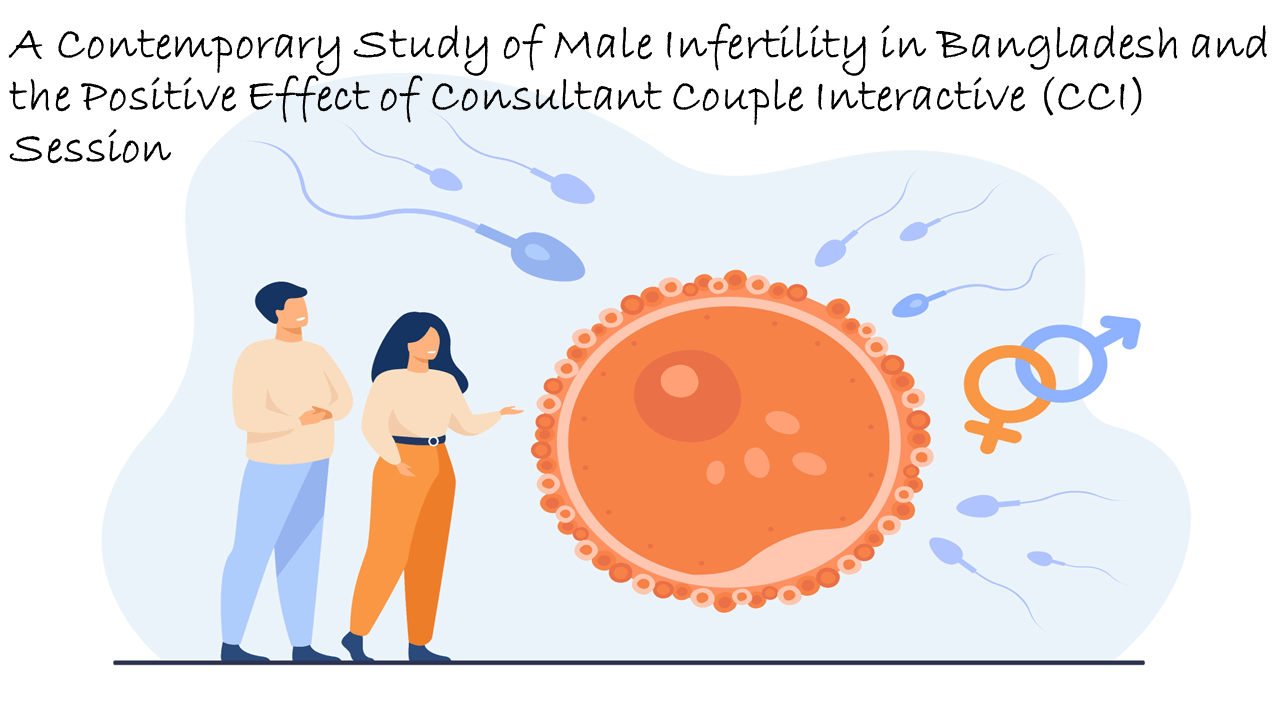A Contemporary Study of Male Infertility in Bangladesh and the Positive Effect of Consultant Couple Interactive (CCI) Session
Infertility is a condition of the male or female reproductive system defined by the failure to conceive after at least a year of unprotected sexual activity, according to the WHO. The majority of infertile couples, who number more than 70 million globally and are found mostly in poorer nations, are married couples. Male factor infertility is now commonly considered to be equally as important as female factor infertility, despite the fact that it was formerly believed that infertility was largely caused by a female aspect. Male infertility makes up a sizeable portion of infertility, and the most common reasons include reproductive tract infections, STDs, varicocele, diabetes, obesity, cystic fibrosis, and hypogonadism. In addition to tight underwear, having mobile devices or computers close to the genitalia, smoking, and extreme exercise have all been linked to lower sperm concentrations in males.
A recent investigation of the knowledge, attitudes, and beliefs of medical students and healthcare professionals in Bangladesh about male infertility was carried out by a group of medical students from several medical colleges in Bangladesh. The main conclusions were that roughly half of the study population lacked adequate knowledge about male infertility and that nearly two-thirds had unfavorable opinions toward it. Medical students and young (23–26 years old) healthcare practitioners were more likely to have solid knowledge. Surprisingly, females were more likely than males to have an optimistic outlook. Doctors with MBBS degrees had the highest likelihood of all occupations to be knowledgeable of male infertility and to view it favorably. Positive attitudes were predicted by having good understanding about male infertility and vice versa.
Only around half (50.18%) of the population in our survey had overall good knowledge, which clearly demonstrated the lack of awareness regarding male infertility. Compared to men, women have much less knowledge. Infertility is connected with such a bad connotation in our culture, which might be attributed to this lack of knowledge. Their findings are in line with a global survey that was carried out during World Fertility Awareness Month and included roughly 17,500 women from 10 different nations (2006). Just half (56.76%) of the participants knew how infertility is identified after at least a year of frequent, unprotected intercourse, which served as more evidence of the lack of knowledge. This could affect the couple’s choice to get help, which shouldn’t be delayed or made too soon.
Only a small number of infertility experts and little to no infertility care equipment are available in public hospitals in Bangladesh to address the vast number of infertile people. Long-term data significantly supported the notion that counseling has a beneficial function in the treatment of infertility. The infertility consultation varies from other symptoms- or disease-oriented consultations in that counselors are significantly more concerned with subjectively defined pain dictated by numerous psychological and psychosocial aspects than with the purpose of discovering a diagnosis. When there is no obvious disease within the couple, appropriate therapy, knowledge about infertility, and support on a psychological and emotional level can lead to success.
A study that looked at 275 couples in Bangladesh conducted both quantitative and qualitative research on the “Effect of Consultant Couple Interactive (CCI) session on fertility result among couples attending a main Infertility Care Center in Bangladesh.” A total of 55 couples (20%) were chosen for the qualitative study, and 41 of them took part. Up to six (12 people) couples were involved in a single, concentrated session. 39% of the 41 couples experienced secondary infertility, while 61% had initial infertility. All respondents were exposed to CCI sessions, however only 186 (67.6%) of them received CCI-based care. Out of the 53 patients (19.3%) who required ovulation-inducing oral medications, only 5 (1.8%) received metformin therapy; the rest patients required a variety of medical and surgical procedures, depending on their individual needs.
Out of 275 responders, 112 (40.7%) became pregnant, and of those who did, 72 (64.3%) did so exclusively after CCI. From the seven FGDs, it was discovered that most couples followed the advise given during the CCI session, the majority were able to strengthen their relationship, and two thirds of the respondents were able to release 75% of the strain placed on them by their surroundings.
Infertile couples’ fertility outcomes are significantly impacted by the consultant couple interactive session, it has been concluded in that research. The amount of oocytes, embryos, and positive pregnancy tests may all be affected by treating anxiety, sadness, and stress, according to studies, which can also change the hormone levels linked to human fertility. As a result, integrative methods to infertility therapy, such as infertility counseling, are the main emphasis of current practice. Although additional research is required to demonstrate how psychological therapies might increase pregnancy rates. Even yet, it can be noted that by participating in Consultant Couple Interactive (CCI) sessions, a sizable portion of childless couples can attain their desired goals while still adhering to the fundamentally normal semen requirements.
Reference:
- Iktidar, M.A., Islam, A.K., Chowdhury, S., Roy, S., Islam, M., Chowdhury, T., Tabassum, M.N., Ali, T.S., Akash, A., Ahmed, M. and Al Zafar, F., 2022. Knowledge, Attitude and Perceptions Regarding Male Infertility among the Medical Students and Healthcare Professionals of Bangladesh. medRxiv.
DOI: 10.1101/2022.02.18.22271175 - Ashraf, F., Aziz, S., Akther, P., Yousuf, M.A., Alamgir, H., Shabnam, N. and Choudhury, M.I.M., 2022. Effect of Consultant Couple Interactive (CCI) session on fertility outcome among couples attending a primary Infertility Care Centre in Bangladesh. Bioresearch Communications, 8(2), pp.1143-1148.
DOI: doi.org/10.3329/brc.v8i2.60645



